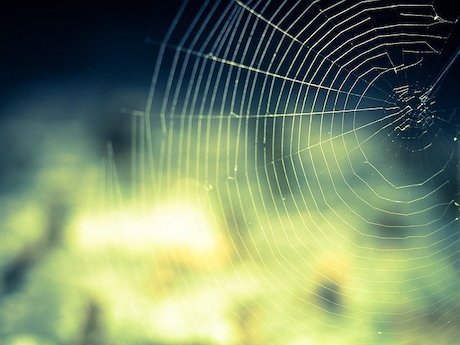
My good friend Jeff Mann, the true Yard Ramp Guy, has asked me to revisit some of my original contributions. And so, my From the Archives series. This week: spider silk!
Oh, What a Tangled Web We Weave

Another Busy Day at the Office?
If you're not a fan of spiders, you may want to skip this one. Otherwise, I just might’ve already snared you:
Spider silk is one of the most magnificent substances in nature, and there are a ton of different types of spider silk.
The silk can be used to capture prey. Along with their classic web-shaped design, spiders build webs in orbs, tangles, sheets, lace, and domes. One type of spider even lowers single-strand webs to go fishing.
Spiders tie up their prey in webs; a few species actually have venomous webs they use for this purpose. Other spiders produce extremely lightweight webs for “ballooning”—spiders blown along for dozens or even hundreds of miles by the wind, often in enormous swarms. (Yay, Australia!) Others use silk to lay trails to and from their web, and create alarm lines with it.
On top of that, spiders usually are capable of creating multiple types of silk—up to seven types in a single species.
Humans have studied and adapted countless different uses for spider silk. The spider-silk protein is comparable in tensile strength to high-grade alloy steel at one-sixth the density. We have stronger materials, like Kevlar, but none nearly so lightweight. (The strongest spider silk variety is more than ten times stronger than Kevlar.)
Spider silk is extremely stretchy and ductile, retaining its useful properties across a huge temperature range. The silk even makes for excellent bandages, due to its antiseptic qualities, and contains high amounts of vitamin K, which is useful in clotting blood.
Yes, the stuff that spiders spin is extremely useful. So, why don't we use it industrially? Because spider-farming doesn't work. Spiders eat each other. Instead, we've turned to genetic engineering. We've tried altering silkworms, E. Coli, goats (they produced it in their milk), tobacco plants, and potato plants to produce the protein.
We haven't mastered silk well enough to mass-produce, yet, but it'll happen eventually. (And then we'll get spider-web suspension bridges. Completely not creepy!)
The Yard Ramp Guy Blog / A Yard Ramp Guy Primer
This week, my friend The Yard Ramp Guy describes how his company rents, sells, and buys new and used yard ramps throughout the United States. It's quite detailed and fascinating.
Click HERE to read the impressive scope of his operation.
